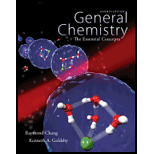
Concept explainers
(a)
Interpretation: The atoms
Concept Introduction:
Electron Affinity: It is energy change taking place when one electron is added to an atom which is neutral in its gaseous state forming an anion.
Along the period, electron affinity increases from left to right expect for Group 2A, Group 8A and Group 5A.
In the case of Group 2A and Group 8A elements, the subshells are completed so the electron has to be added to a subshell with higher energy.
In the case of Group 5A elements, the p subshell is half–fill hence has high electron–electron repulsion.
Down the group, the electron affinity values vary a little.
(b)
Interpretation: The atoms
Concept Introduction:
Electron Affinity: It is energy change taking place when one electron is added to an atom which is neutral in its gaseous state forming an anion.
Along the period, electron affinity increases from left to right expect for Group 2A, Group 8A and Group 5A.
In the case of Group 2A and Group 8A elements, the subshells are complete so the electron has to be added to a subshell with higher energy.
In the case of Group 5A elements, the p subshell is half–fill hence has high electron–electron repulsion.
Down the group, the electron affinity values vary a little.
(c)
Interpretation: The atoms
Concept Introduction:
Electron Affinity: It is energy change taking place when one electron is added to an atom which is neutral in its gaseous state forming an anion.
Along the period, electron affinity increases from left to right expect for Group 2A, Group 8A and Group 5A.
In the case of Group 2A and Group 8A elements, the subshells are complete so the electron has to be added to a subshell with higher energy.
In the case of Group 5A elements, the p subshell is half-fill hence has high electron–electron repulsion.
Down the group, the electron affinity values vary a little.
Want to see the full answer?
Check out a sample textbook solution
Chapter 8 Solutions
Workbook with Solutions to Accompany General Chemistry
 ChemistryChemistryISBN:9781305957404Author:Steven S. Zumdahl, Susan A. Zumdahl, Donald J. DeCostePublisher:Cengage Learning
ChemistryChemistryISBN:9781305957404Author:Steven S. Zumdahl, Susan A. Zumdahl, Donald J. DeCostePublisher:Cengage Learning ChemistryChemistryISBN:9781259911156Author:Raymond Chang Dr., Jason Overby ProfessorPublisher:McGraw-Hill Education
ChemistryChemistryISBN:9781259911156Author:Raymond Chang Dr., Jason Overby ProfessorPublisher:McGraw-Hill Education Principles of Instrumental AnalysisChemistryISBN:9781305577213Author:Douglas A. Skoog, F. James Holler, Stanley R. CrouchPublisher:Cengage Learning
Principles of Instrumental AnalysisChemistryISBN:9781305577213Author:Douglas A. Skoog, F. James Holler, Stanley R. CrouchPublisher:Cengage Learning Organic ChemistryChemistryISBN:9780078021558Author:Janice Gorzynski Smith Dr.Publisher:McGraw-Hill Education
Organic ChemistryChemistryISBN:9780078021558Author:Janice Gorzynski Smith Dr.Publisher:McGraw-Hill Education Chemistry: Principles and ReactionsChemistryISBN:9781305079373Author:William L. Masterton, Cecile N. HurleyPublisher:Cengage Learning
Chemistry: Principles and ReactionsChemistryISBN:9781305079373Author:William L. Masterton, Cecile N. HurleyPublisher:Cengage Learning Elementary Principles of Chemical Processes, Bind...ChemistryISBN:9781118431221Author:Richard M. Felder, Ronald W. Rousseau, Lisa G. BullardPublisher:WILEY
Elementary Principles of Chemical Processes, Bind...ChemistryISBN:9781118431221Author:Richard M. Felder, Ronald W. Rousseau, Lisa G. BullardPublisher:WILEY





